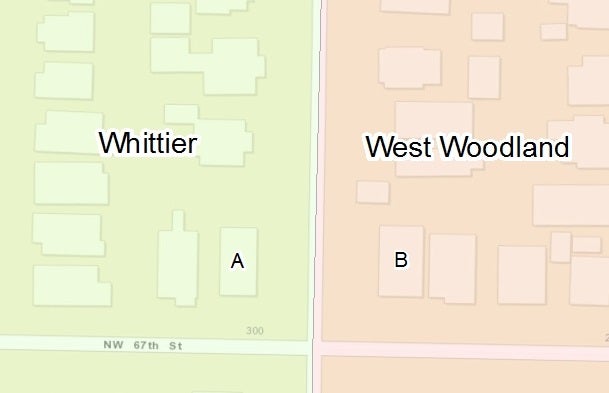FAQ on Boundary Changes
Frequently Asked Questions About Boundary Changes
If you have other questions, please use the gold Let’s Talk button on this page.
Which schools have new boundaries for 2022-23?
There were no boundary changes for 2022-23.
My address is close to the boundary line. How do I know which boundary includes my address?
Boundary lines typically run down the center of the street. Addresses located on attendance area boundary streets will be assigned to their attendance area schools depending on the side of the street where the home is located. In the sample below, residents of building A are assigned to Whittier, while residents of building B are assigned to West Woodland.

How are boundaries changed?
With changes in the number of students enrolled, there is sometimes a need to adjust school attendance area boundaries. These boundary changes are discussed with principals at impacted schools, and then the Enrollment Planning team meets with the community to share information and listen to input.
Data and community input is reviewed, and if staff believes a boundary change is needed, a recommendation to the School Board is prepared.
Recommendations to School Board at one of their regular meetings. At a future meeting, usually the next regular meeting, the School Board then acts on the proposal.
Who decides on the changes?
Changes to boundaries are implemented when capacity needs to be balanced among schools, including if new schools are opened or space is expanded, or if enrollment increases or drops. These changes must be approved by the Seattle School Board.
Why are these changes necessary?
School boundaries need to be adjusted to accommodate changes in the number of students enrolled at schools.
How are the enrollment projections that influence boundary decisions made?
Please visit the Enrollment Planning page to learn about projections.
Will there be additional changes in the future?
On occasion, a boundary change may be recommended to balance enrollment. When additional schools are renovated, replaced, or built using capital levies, boundaries may need to be adjusted to accommodate that capacity change. Changes may also be made to balance the number of students between schools when enrollment patterns change.
Will current elementary students be grandfathered?
Grandfathering decisions are made by the Seattle School Board.
Is transportation provided for grandfathered students?
The Seattle School Board makes decisions on transportation for grandfathered students.
Will transportation be provided to the new attendance area school?
If a student is outside the walk zone for the new attendance area school, transportation will be provided following usual school district transportation rules.
What about siblings? Can they go to school with the students who are grandfathered?
If grandfathering is available, it applies only to students currently enrolled in a school and is in effect through the highest grade at that school (5th or 8th grade) as long as the services the student needs are available at that school.
Any student entering school after boundary changes are implemented will be assigned to the new attendance area school, including siblings.
The first tiebreaker for a choice assignment is always “sibling,” so it may be possible for a younger child to apply and enter through Open Enrollment.
If my student is grandfathered, do I need to fill out a choice form to keep my student at the same school?
Students who are grandfathered will automatically continue to be enrolled in their current school. No choice form or other paperwork is required.
What if a student is grandfathered but wants to move to the new attendance area school?
To attend the new attendance area school, families need to fill out a School Choice form to alert the district that they do not wish to be grandfathered. A seat at the new attendance area school is guaranteed if the home address falls within the boundaries. If the new school is opening as a “roll up” with only a few of the early grades, it may not be possible for an older student to move to the new school.
If a student is grandfathered in elementary school, where will he or she go to middle school?
Once a grandfathered student completes the highest grade offered at the school (5th or 8th grade), attendance at middle school or high school is based on the home attendance area.
If a student is currently enrolled in a school through the choice process, will that student be impacted by grandfathering decisions?
No. Once a student receives a choice assignment, they may remain at that school through the highest grade level.
If a student has an IEP, will that student be impacted by boundary changes and grandfathering decisions?
In most instances, students requiring special education services will follow the same boundary change guidelines as general education students. Special Education services (and assignments) depend on the student’s IEP. Most services are offered at all schools, but in some instances, certain services may only be provided at certain schools.
If a student is experiencing homelessness, will that student be impacted by boundary changes and grandfathering decisions?
No. As provided in the McKinney-Vento Homeless Assistance Act, students experiencing homelessness will not be impacted by boundary changes.
Last updated:1/6/2023
